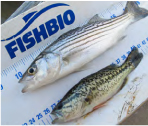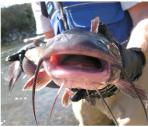Native Fish Recovery Efforts
A new collaborative project seeks to improve the conditions of the Stanislaus River to support thriving populations of native fish such as salmon and trout. Young fish rearing and migrating in the river face many threats, including being eaten by predators. Many of these predators are non-native, introduced species that can severely stress native fish populations.
This project is investigating whether the removal of non-native fish can reduce predation on young salmon and improve their survival and migration through the Stanislaus River. The project is a collaboration between FISHBIO and NOAA Fisheries, with funding from the Oakdale and South San Joaquin irrigation districts. The work is authorized by recent federal legislation to improve rivers in the United States. From February through May for the next five years, non-native predators will be counted and experimentally removed from some parts of the river. The resulting impacts to the survival of migrating juvenile salmon will be analyzed and the data shared publicly. What is learned will add important information to the discussion about how to sustainably increase the salmon population in the river.
Project Question
Can reducing the number of non-native predatory fish help increase the survival of young salmon and the abundance of native fish in the Stanislaus River?
Project Goals
1. Measure the abundance of non-native predators in the Stanislaus River and experimentally remove fish from some areas of the river to reduce predator abundance.
2. Measure juvenile salmon survival through tracking technology.
3. Use project results to design management actions that will benefit native fish in the Stanislaus River.
A Stanislaus Success Story from Restoration and Collaboration
The Oakdale and South San Joaquin irrigation districts believe managing water means being good stewards of our local rivers. The Stanislaus River Native Fish Plan represents one piece of the districts’ larger effort to improve the quality of the river. For the past two decades, the districts have adopted water conservation measures and supported a wide variety of fisheries research and monitoring activities to study which conditions provide the most benefit to native fish. This work helped inform the design of a floodplain restoration project on the Stanislaus River at Honolulu Bar, completed in 2011.
The Honolulu Bar project represented a collaborative effort between FISHBIO, the Oakdale Irrigation District, the U.S. Fish and Wildlife Service, CBEC and River Partners. Steep river channels were leveled to create shallow flooded areas for fish rearing, and gravel was sorted and placed in the river to improve spawning habitat. Community members helped plant native trees and shrubs along the floodplain. Salmon and trout quickly made use of the newly restored habitat, reflecting the value of using research to inform restoration.
Who is FISHBIO?
FISHBIO will lead scientific research and monitoring for the Stanislaus River Native Fish Plan. FISHBIO is a fisheries and environmental consulting company dedicated to advancing the research, monitoring, and conservation of fish around the world. Its highly skilled scientists, engineers and technicians are committed to solving a variety of fisheries and natural resource management challenges.
FISHBIO has its headquarters in Oakdale. It has worked with the Oakdale Irrigation District to assess and conserve fish and water resources in the Stanislaus River since 1991. Long-term fisheries monitoring on the river includes a fish-counting weir to monitor adult Chinook salmon migration, spawning surveys and rotary screw traps to monitor juvenile fish migrating downstream. These monitoring activities are implemented by the Oakdale and South San Joaquin irrigation districts and FISHBIO. We are committed to conducting sound science to improve the management of the Stanislaus River’s native fish populations.





